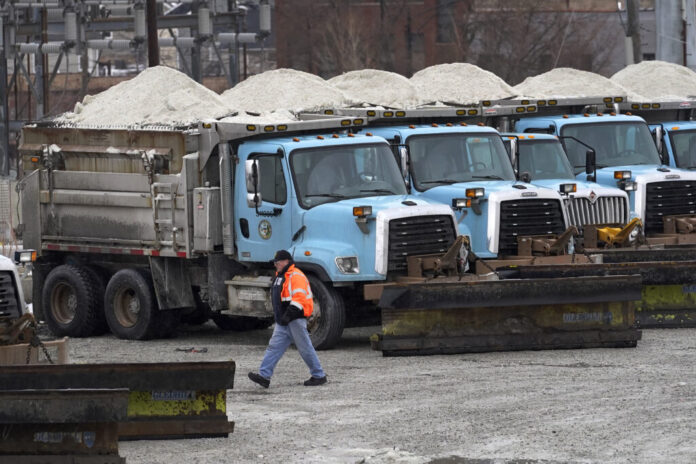The Fort Worth water department had all hands on deck in February 2021, attempting to respond to the challenges of Winter Storm Uri as one water treatment plant went down – and then another and then another and another.
The power outage forced over 300,000 Tarrant County residents to boil their water, while other residents were left without any water at all. The memories of the February storm remain fresh in the minds of every city employee, Chris Harder, head of the Fort Worth Water Department, said.
“That whole day Feb. 15, 2021, was spent trying to get power restarted to the plants,” Harder said. “And then on top of that, it was super frustrating because when power did get restored, the plants had been down for so long that many of the piping had frozen up.”
Before February 2021, the water department thought it had safeguards in place to prevent catastrophic failures. Each of the four water treatment facilities that went down were in different parts of the city, connected to different parts of the power system with two different power feeds.
“If we lose one plant, the others can pick up the pace,” Mary Gugliuzza, communications director for Fort Worth water, said.
Fort Worth didn’t lose one plant; it lost four. After last year’s storm revealed weaknesses, Harder said, the city made changes to prevent multiple water treatment plants from failing at the same time. Fort Worth bought generators to keep pipes from freezing during outages and began creating a plan to improve critical infrastructure.
Generators have already been purchased, but Harder said the department is still in the process of getting quotes and starting construction on projects to improve weather resiliency of pump stations and water treatment plants, including replacements of pipes across the city.
“These identified infrastructure improvements are not ready this winter,” Harder said.
Improvements are underway, though. Tuesday, the City Council is expected to approve nearly $100,000 to go toward building a structure to enclose the Eagle Mountain and Westside Water Treatment Plant Pump Stations, the council has already approved about half a million dollars to go toward the project.
In compliance with Senate Bill 3, the water department also reported its list of critical facilities to the Public Utility Commission. That process resulted in more city utility facilities being added to a list of critical infrastructure by Encor, Harder said.
“One of the things that is very, very important to realize is that being on the critical list does not guarantee that you will not be interrupted,” Harder explained.
The water department will submit an emergency preparedness plan that creates a backup strategy to maintain power to facilities during an outage. The department will have to submit that plan to the Texas Commission on Environmental Quality by March 1.
The water department will work with other city departments and government entities to prepare for future extreme weather events. At a Feb. 15 meeting, the Tarrant Regional Water District Board discussed how it plans to coordinate emergency preparedness plans with their customers, including Arlington, Fort Worth and Mansfield and the Trinity River Authority.
Devin Taylor, energy manager with the water district, said the agency is working on coordination so that, if and when the power goes out, partners can determine what resources can be shifted around to keep water flowing in the midst of an outage. The water district will also have to submit an emergency preparedness plan.
It wasn’t just utilities that were impacted by the winter storm. When disaster strikes, the Fort Worth Fire Department’s Office of Emergency Management activates the Emergency Operations Center to create a central location for representatives from all city departments to coordinate efficiently.
A representative of the office said the severity of the winter storm has raised public awareness of the potential severity of future storms and increased the office’s ability to effectively communicate with residents.
Steve Cooke, head of the city of Fort Worth’s property management department, said the best asset his department has in times of emergency are its people.
“We try to make sure we have the materials we need,” Cooke said. “And the labor, we don’t have to worry about. My guys show up every time, it’s pretty remarkable.”
The storm didn’t have a huge impact on how his department manages the 291 buildings that belong to the city, Cooke said. He will likely apply new standards of resilience to buildings still under construction, like the new City Hall being refurbished at 100 Energy Way, he said.
“We’re certainly considering some changes,” Cooke said. “We’ve begun to expand our thoughts on what other elements we would want to have running on generator power.”
Department heads all described remembering the details of the storm over a year later.
“That was a stress test last year,” Harder said. “and it’s not just water utilities, it’s electric utilities, it’s gas utilities. The whole utility business across Texas learned a lot.”
Rachel Behrndt is a government accountability reporter for the Fort Worth Report. Contact her at rachel.behrndt@fortworthreport.org or via Twitter. At the Fort Worth Report, news decisions are made independently of our board members and financial supporters. Read more about our editorial independence policy here.
This article was originally published by Fort Worth Report.






